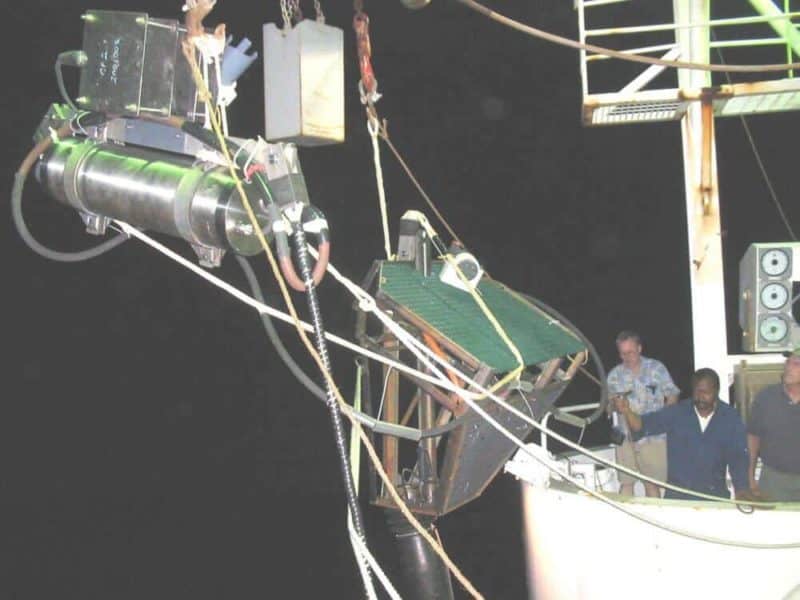The ALOHA Cabled Observatory (ACO), the deepest operating ocean observatory on the planet that provides power and internet communications to scientific instruments on the seafloor, recently celebrated 10 years of operations. The development and deployment of the nearly 3-mile deep observatory was led by the University of Hawai‘i at Mānoa (UHM) School of Ocean and Earth Science and Technology (SOEST) and supported by grants from the National Science Foundation to UHM.
“Since the HMS Challenger plumbed the deeps during its 1876 circumnavigation, measurements of the deep ocean have remained sporadic and extremely sparse in time and space. Our goal at ACO has been to establish a permanent toehold in this extreme abyssal environment, enabling discovery and sustained study of the ocean at Station ALOHA,” said Bruce Howe, principal investigator for ACO and professor at SOEST.
In 2007, a retired AT&T cable, running from Hawai‘i to California, was retrieved off the seafloor–where it had rested for almost 20 years–and brought to Station ALOHA, the site of UHM’s Hawai‘i Ocean Time-series program (HOT). Through HOT, scientists have been studying upper-ocean variability at Station ALOHA since 1988 during monthly cruises. The cable repurposing required a 513-foot US Navy cable repair ship, Zeus, with its grapple and large cable engines. Once on board, the cable was cut and a frame with a pressure sensor and hydrophone (to record sound) was attached to the free end of the cable. The assembly was lowered down to the ocean floor and the ACO was born–connecting equipment on the seafloor to a shore station in Makaha, Oʻahu.
“If the hydrophone worked, it would prove the future possibilities of a deep-sea observatory there,” said Fred Duennebier, geology professor emeritus and ACO pioneer. “On February 16, 2007, the instruments landed on the bottom and moments later scientists on land could hear the singing of humpback whales in real-time through the cable.”
In 2011, sensors that measure temperature, salinity, currents and acoustics, and a video camera were added using the remotely operated vehicle ROV Jason.
“On the morning of June 6, researchers on land could see the seafloor illuminated by LED lights through the video camera plugged into the Observatory,” said Howe. “They could hear the sound of the ocean, with all its clicks and songs, through the hydrophones installed. They could see the temperature and salinity of the water change ever so slightly with time and chart the currents up to 100 meters off the seafloor. The ALOHA Cabled Observatory had succeeded and continues to shed light on the science of the seafloor and the water column above.”
On the last maintenance cruise, the UHM ROV Lu’ukai was used to plug in another new sensor and will be used in future visits to add instrumentation and service what is there.
The ACO provides infrastructure for continuous, interactive ocean sampling. On-going scientific research includes studies of deep-sea biology; abyssal circulation and mixing; and acoustic signatures of earthquakes, ships, marine mammals, waves, wind and rain. New insights have been gained as a result of the cabled observatory providing continuous and substantial power for lights and camera and real-time communications for the voluminous video data. ACO researchers have observed never-before-seen animal interactions and gained new understanding of deep ocean processes. Their discoveries and observations at ACO have challenged the conventional thinking that the deep ocean was relatively quiet and constant.
Support for the ACO began in 2002 when the National Science Foundation (“NSF”) approved the proposal that would push work on the observatory forward. In 2007, NSF and the Office of Naval Research provided support for the USNS Zeus to recover, cut, terminate and relocate the HAW-4 fiber optic telecommunications cable to Station ALOHA. AT&T transferred the cable to the Research Corporation of the University of Hawaiʻi for a nominal fee. In addition, ACO has been made possible by the collaborative and substantial efforts of many individuals and organizations. Detailed acknowledgements are available on the website.


